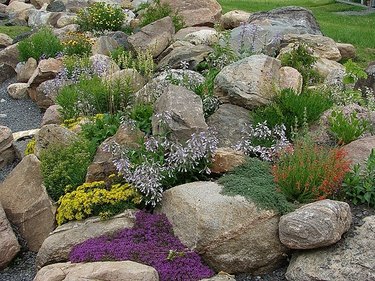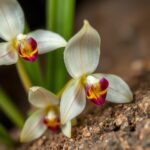Top 10 Stunning Plants for Rockeries Australia: A Complete Guide for Your Garden

Creating a stunning rockery garden can transform your outdoor space into a breathtaking oasis. In Australia, diverse climates and landscapes offer a unique opportunity to showcase an array of captivating plants that thrive in rocky settings. This guide highlights the top 10 stunning plants perfect for rockeries across the continent, ensuring your garden is both beautiful and resilient. From vibrant ground covers to striking succulents, discover the ideal selections that will thrive in your rock garden while adding visual appeal and enhancing biodiversity. Let’s explore these remarkable plants that promise to elevate your garden design to new heights.
Best Plants for Rockeries in Australia
Rockeries are a popular feature in Australian gardens, as they provide an excellent way to incorporate native plants that thrive in the country's diverse climates. When selecting plants for rockeries, it’s essential to choose species that are drought-tolerant, require minimal maintenance, and can withstand rocky soil conditions. Some of the best options include succulents, grasses, and perennials that not only enhance the natural beauty of the rockery but also support local wildlife. Additionally, using a combination of colors, textures, and heights can create a visually appealing landscape that reflects the ruggedness of the Australian environment.
1. Native Succulents
Native succulents such as Sedum and Crassula are ideal for rockeries in Australia due to their ability to retain moisture and flourish in arid conditions. They provide striking foliage and can produce vibrant flowers that attract pollinators like bees and butterflies. These plants generally require minimal watering and care, making them a great addition for gardeners seeking low-maintenance options.
2. Drought-Tolerant Grasses
Drought-tolerant grasses, such as Themeda triandra (Kangaroo Grass) and Poa labillardierei, are excellent choices for rockeries as they offer movement and texture. These grasses are well-suited to Australia's varied climate and can survive in poor soil conditions. They provide a lush appearance during the growing season while conserving water and maintaining resilience through dry periods.
3. Ground Covers
Ground covers like Dichondra repens and Carpobrotus (Pigface) are essential for stabilizing the soil in rockeries and preventing erosion. They spread out and create a carpet-like effect, which not only enhances the aesthetic appeal of the space but also serves functional purposes like weed suppression. These hardy ground covers are suited for full sun and can often tolerate salt and wind, making them perfect for coastal regions.
4. Flowering Perennials
Flowering perennials, such as Echinacea and Lavandula (Lavender), add vibrant colors and scents to rockeries. These plants are beneficial for attracting beneficial insects and can endure tough conditions once established. With their long blooming seasons, they bring life and dynamism to the rockery, enhancing the overall garden ambiance.
5. Compact Shrubs
Compact shrubs like Callistemon (Bottlebrush) and Grevillea can provide structure and height to rockeries, offering a contrast to lower-growing plants. These shrubs often showcase striking flowers that not only beautify the garden but also provide vital resources for local wildlife. Their adaptability to different soil types allows them to thrive in rockeries, contributing to a biodiverse landscape.
| Plant Type | Characteristics | Benefits |
|---|---|---|
| Succulents | Drought-tolerant, vibrant foliage | Low maintenance, attracts pollinators |
| Grasses | Drought-tolerant, resilient | Provides texture, conserves water |
| Ground Covers | Spreading, low growing | Soil stabilization, weed suppression |
| Perennials | Colorful blooms, aromatic | Attracts beneficial insects, long blooming season |
| Shrubs | Compact, structural | Enhances biodiversity, attracts wildlife |
What are the best plants to grow in a rockery?

The best plants to grow in a rockery are those that thrive in well-drained soil and can withstand varying weather conditions. Here are some of the most suitable plants for this type of garden feature:
- Alpine plants: These plants are adapted to grow in rocky, mountainous regions and are perfect for rockeries. They usually have a compact growth habit and come in an array of colors.
- Sedums: Known for their succulent foliage, sedums are drought-resistant and can thrive in poor soil conditions. They add texture and color with their fleshy leaves and vibrant flowers.
- Thyme: This aromatic herb not only provides culinary benefits but also works well in rockeries due to its low-growing, spreading nature. It creates a fragrant ground cover and attracts pollinators.
- Heathers: These hardy evergreen plants offer year-round greenery and colorful blooms. Heathers prefer acidic soil, making them suitable for rocky terrains.
- Rockroses: With their vibrant flowers and resilience to drought, rockroses are an excellent choice for adding pops of color to rock gardens.
Choosing the Right Location
Selecting the proper spot for your rockery is crucial. A sunny location with good drainage will help ensure the success of the plants. Consider the following factors when choosing the location:
- Sunlight: Most rockery plants prefer full sun, so ensure the chosen area receives ample light.
- Drainage: Good drainage is vital for preventing root rot, which is common in heavy, wet soils.
- Proximity to other plants: Be mindful of how rockery plants will interact with surrounding flora, ensuring they have ample space to grow.
Soil Preparation
Preparing the soil correctly can significantly affect the growth of rockery plants. Here's how to prepare your soil:
- Remove weeds: Clear the area of any weeds or unwanted plants that might compete for nutrients.
- Improve drainage: Incorporate sand or gravel into the soil to enhance drainage capabilities.
- Check pH levels: Some plants prefer acidic, neutral, or alkaline conditions, so testing and adjusting the soil pH is beneficial.
Planting Techniques
Proper planting techniques will help your rockery plants establish and thrive. Follow these tips for effective planting:
- Spacing: Allow enough space between plants to prevent overcrowding, which can lead to disease.
- Depth: Ensure that plants are planted at the correct depth according to their needs.
- Watering: Water the plants well after planting to help them settle, but avoid waterlogging the soil.
Maintenance of Rockery Plants
Maintaining rockery plants is essential for a thriving garden. Regular care can make a significant impact. Consider these maintenance tips:
- Watering Schedule: Establish a watering routine, particularly during dry spells, while being cautious not to overwater.
- Pruning: Regularly prune dead or diseased foliage to encourage healthy growth and air circulation.
- Mulching: Apply a layer of mulch to regulate soil temperature and help retain moisture.
Companion Planting in Rockeries
Companion planting can enhance the beauty and functionality of rockeries. Here are some benefits and considerations:
- Diversity: Mixing various plant types can create a more visually appealing rockery.
- Support ecosystem: Companion plants can attract beneficial insects while deterring pests.
- Maximize space: By choosing companions with varying heights and growth patterns, you can make the most of your rockery.
What plants are good for rock beds?
:max_bytes(150000):strip_icc()/rock-garden-plants-2132908-hero-e0f8d4acad4b459f9af96a1c719a51a1.jpeg)

Certainly!
When it comes to selecting plants that thrive in rock beds, it's essential to pick varieties that are adaptable to the well-draining, sometimes harsh conditions that rocky environments can present. Here are some excellent choices for plants suitable for rock beds:
Creeping Thyme
Creeping thyme is a resilient, low-growing perennial that flourishes in rock beds due to its ability to tolerate poor soil and drought conditions. This plant adds a lovely aromatic quality and produces small purple flowers that attract pollinators.
- Low Maintenance: Requires minimal care and is drought-resistant.
- Colorful Blooms: Offers vibrant blooms during the warmer months.
- Ground Cover: Perfect for filling spaces and preventing weeds.
Sedum (Stonecrop)
Sedum, commonly known as stonecrop, encompasses a wide variety of succulent plants that thrive in rocky environments. Their fleshy leaves enable them to store water, enabling them to survive dry conditions.
- Diverse Varieties: Comes in many different shapes and colors.
- Attracts Wildlife: Attracts bees and butterflies, promoting biodiversity.
- Soil Adaptability: Thrives in poor, sandy, or rocky soils.
Alpine Aster
The Alpine aster is a hardy perennial native to mountainous regions, making it an excellent candidate for rock beds. This plant features beautiful purple or blue flowers that can dance in the breeze and provide a pop of color.
- Cold Tolerance: Can withstand colder climates and frost.
- Varied Bloom Times: Offers seasonal interest with flowers that bloom in spring through summer.
- Compact Growth: Does not grow too tall, ideal for rocky landscapes.
Russian Sage
Russian sage is a robust perennial that combines stunning silvery foliage with lavender-blue flowers. It flourishes in rock beds due to its drought and heat tolerance while also standing up well against poor soil quality.
- Aesthetic Appeal: Adds height and drama to rock gardens.
- Pollinator-Friendly: Attractive to bees and butterflies.
- Longevity: Years of vibrant life with minimal maintenance.
Penstemon (Beardtongue)
Penstemon, or beardtongue, is a native North American perennial that thrives in sunny, rocky locations. With numerous species to choose from, these plants produce tubular flowers that add vertical interest to rock beds.
- Drought Tolerance: Well-suited for dry environments.
- Long Blooming Period: Flowers throughout the summer, providing extended visual appeal.
- Variety of Colors: Available in multiple shades, from red to purple to blue.
What plants can you put in a rock wall?

To create a stunning rock wall garden, choosing the right plants is essential. Here are some plants that thrive well in a rock wall environment:
1. Succulents: These plants are ideal for rock walls as they can tolerate dry conditions. They store water in their leaves, making them perfect for sunny locations.
2. Creeping Thyme: This hardy herb enjoys full sun and well-draining soil. Its low-growing habit makes it an excellent choice for softening the edges of a rock wall.
3. Sedum: This diverse group of plants is known for their colorful foliage and flowers. Many varieties are drought-resistant and can easily adapt to rocky environments.
4. Stonecrop: Similar to sedum, stonecrop plants have fleshy leaves and can thrive in poor soil conditions. Their ability to resist drought makes them a great fit for rock walls.
5. Alpines: These plants are adapted to grow in rocky and harsh conditions. They add unique textures and colors to any rock wall.
Choosing the Right Location
When planning your rock wall garden, it's essential to consider its orientation and exposure to sunlight. Each plant has specific light requirements, so aim for a mix that suits your environment.
See also:
- Full Sun: Select plants that can handle direct sunlight, such as succulents and creeping thyme.
- Partial Shade: Consider plants like ferns or certain alpines that thrive in less direct light.
- Proper Drainage: Ensure that the rock wall allows for fast drainage to support plant health.
Planting Techniques
Proper planting techniques can enhance the longevity and aesthetic appeal of your rock wall plants. This involves understanding the best way to place each plant.
- Soil Preparation: Use a well-draining mix to prevent rot, ideal for succulents and sedums.
- Planting Depth: Ensure that you plant at the right depth, usually just below the soil line for stability.
- Spacing: Give each plant enough space to grow and spread without overcrowding.
Maintenance Tips
Regular maintenance is crucial for the health of the plants in your rock wall. Knowing how to care for them will keep them thriving.
- Watering: Ensure plants are watered appropriately, especially during dry spells; most rock wall plants prefer less frequent watering.
- Weeding: Regularly check for weeds that can compete with your desired plants for nutrients.
- Pruning: Trim back any overgrowth to promote healthy growth and maintain the desired appearance.
Seasonal Considerations
Understanding how different seasons affect growth can help keep your rock wall plants healthy all year round.
- Winter Protection: Certain plants may need protection from frost; consider mulching to insulate the soil.
- Spring Care: Inspect plants for winter damage and prune any dead foliage as new growth begins.
- Autumn Preparation: Reduce watering as plants enter dormancy in the fall; this helps prevent root rot.
Plant Combinations for Aesthetic Appeal
Experimenting with different combinations of plants can create an eye-catching display.
- Color Themes: Choose plants based on color schemes, such as vibrant succulents with grey stones for contrast.
- Height Variation: Plant taller varieties at the back of the rock wall and shorter ones in front for depth.
- Textural Contrast: Mix fleshy leaves of sedums with the delicate flowers of creeping thyme for visual interest.
How to make a rock garden in Australia?

To create a successful rock garden in Australia, it's essential to consider the native flora, the landscape's natural characteristics, and the local climate. This guide explains step-by-step how to construct a rock garden that thrives in the Australian environment.
Understanding Your Space
It's crucial to assess your garden area before starting. Consider the following elements to design a rock garden that complements your landscape:
- Sunlight: Determine how much sun the area receives daily. Most Australian plants prefer full sun.
- Drainage: Ensure that the area has good drainage to prevent waterlogging, which is detrimental to many plants.
- Soil Type: Test the soil type, as sandy or rocky soils are often more suitable for rock gardens than heavy clay.
Choosing the Right Rocks
Selecting appropriate rocks is vital for the aesthetic and structural integrity of your rock garden. Here are some tips for choosing rocks:
- Local Stone: Use stones native to your region, such as sandstone or granite, to create a natural look.
- Size Variations: Combine different sizes of rocks to add depth and interest to the garden.
- Placement: Arrange rocks to mimic natural formations, allowing for plants to grow in between them.
Selecting Suitable Plants
When designing your rock garden, it’s important to choose plants that can thrive in your local climate. Here are some options:
- Succulents: Varieties like Aloe and Echeveria are drought-resistant and perfect for arid regions.
- Native Grasses: Consider incorporating grasses like Lomandra and Poaceae for texture and movement.
- Flowering Plants: Incorporate low-growing native flowers such as Wattle or Grevillea for seasonal color.
Building the Rock Garden
The construction phase involves placing the rocks and preparing the soil for planting. Follow these steps to build a stable rock garden:
- Site Preparation: Clear the area of debris and level the ground to create a solid foundation.
- Rock Placement: Begin placing larger rocks at the base, gradually layering smaller rocks on top, ensuring stability.
- Soil and Mulch: Fill in spaces between rocks with well-draining soil and add mulch to retain moisture while suppressing weeds.
Maintaining Your Rock Garden
Once your rock garden is established, ongoing maintenance is key to its longevity. Pay attention to the following aspects:
- Watering: Water newly planted areas regularly until established, then allow the garden to dry out between waterings.
- Weeding: Check for and remove any weeds to prevent competition for nutrients.
- Pruning: Trim back overgrown plants to maintain the desired shape and encourage healthy growth.
Questions from Our Readers
What are the best plants for rockeries in Australia?
The best plants for rockeries in Australia include native species that thrive in arid conditions. Popular choices are succulents, aloe vera, and various types of grasses such as blue fescue. These plants are well-suited to the rocky, well-drained environments typical of rockeries.
How much sunlight do rockery plants need?
Most rockery plants in Australia prefer full sun to partial shade, making them ideal for sunny gardens. However, it’s essential to consider the specific needs of each plant, as some may enjoy a bit of afternoon shade during the hottest months, especially in warmer regions.
How often should I water rockery plants?
Rockery plants generally require minimal watering due to their adaptation to dry conditions, but it's important to water them during periods of extreme heat or drought. Allow the soil to dry out between watering sessions to prevent root rot, which can be detrimental to these hardy plants.
Can I use non-native plants in my rockery?
Yes, you can use non-native plants in your rockery, but it's crucial to select species that are suitable for your local climate and environment. Choosing low-water and drought-tolerant varieties can help ensure their success while maintaining the aesthetic of your rockery without harming the local ecosystem.
See also:

If you want to read more articles like Top 10 Stunning Plants for Rockeries Australia: A Complete Guide for Your Garden, we recommend you check out our Landscaping category.
Leave a Reply
Related Articles